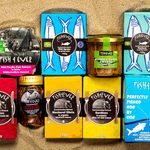You have no items in your shopping cart.
Biodiversity describes the variation of life on earth including all living things, from bacteria to plants and animals to humans. Experts assume that so far only about 14% of all species contributing to the world’s biodiversity have been discovered. But even though we don’t know all the cogs in our planet’s ecosystems, we understand that all their complex forms and interactions are essential to their health and act as a safety net for humanity. Our planet’s biodiversity is sensitively balanced. All organisms in one ecosystem are interdependent, which is why the extinction of one species could lead to fatal irreversible consequences for all other species on earth, including humankind.

But human activities threaten biodiversity and thus our ecosystems. In recent decades, humans have steadily outgrown the earth's boundaries, causing an irreversible biodiversity loss.
One of the reasons for this is the industrial farming our kind developed to feed its ever-growing population. Even though farms should be rich in plant and wildlife, intensive farming methods like mono-cropping and the over-use of agrochemicals have caused this major biodiversity loss. Soils are becoming increasingly degraded and polluted, with valuable nutrients and microorganisms in soil diminishing.
While pesticides and fertilisers fight plant diseases and are therefore sold as indispensable for intensive farming, they massively harm plant, insect and bird populations. The toxic chemicals that are supposed to promote plant growth and keep their natural enemies away can be deposited and accumulate in surrounding soils and waters, polluting the environment with chemical runoff years after they are used in intensive agriculture. Moreover, pests can develop resistance meaning more and more chemicals have to be used to combat diseases. Thus, agrochemicals not only affect Organisms directly, but also indirectly e. g. via the food chain. If one component of the food chain is impacted, the entire ecosystem is at risk.
So how does organic farming help?
Through methods such as crop rotation and the introduction of natural predators, organic farming works with the natural environment, not against it. By valuing clean waterways, rich soils and banning the use of most agrochemicals, organic farms have become havens for wildlife.

Organic farming allows ecosystems to function in their natural behaviour as far as possible. Thus, it relies on a great diversity of species, because the more species the farm’s small ecosystem contains, the more balanced and healthy it is. Experts still argue about the numbers, but according to several consistent studies, organic farms have on average about 30% more species than conventional farms. They also have more semi-natural vegetation areas, which include all plants not used for arable farming and which are important for pollination and thus biodiversity, pest control or erosion control. The figures show that on organic farms about 22 % of the area consists of this near-natural vegetation, while on conventional farms the proportion is considerably lower. Promoting healthy, organic plant growth is therefore an indispensable approach to ensuring a sustainable future for humanity and its planet.













